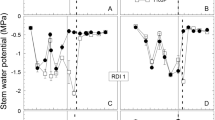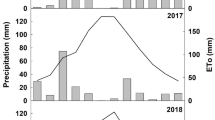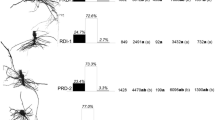Abstract
A field experiment was carried out over three seasons on Vitis vinifera cv. Tempranillo in order to compare pre-veraison and post-veraison water restrictions on vine performance and fruit composition. Rain-fed vines were compared with a treatment named MAX that was constantly irrigated at 75 % of the estimated crop evapotranspiration (ETc). In addition, an early (pre-veraison) water deficit strategy (ED) was applied by withholding irrigation until plant water stress experienced by vines surpassed a threshold value of midday stem water potential of −1.0 MPa. After that, 75 % of ETc was applied. A late season deficit (LD) treatment was irrigated as per the MAX up to veraison, and thereafter, water application was reduced to approximately 37 % of ETc. All irrigation regimes increased vine yield up to 58 % with respect to the rain-fed treatment, and no differences in yield among the irrigated treatments occurred. However, there were differences in berry composition among the different irrigation strategies. The ED strategy was more effective than the LD one in reducing berry growth leading to more concentrated berries in terms of sugars and anthocyanins. The LD water shortage impaired berry sugar accumulation due to the detrimental effect of water stress on leaf photosynthesis.





Similar content being viewed by others
References
Allen RG, Pereira LS, Raes D, Smith M (1998) Crop evapotranspiration. Guidelines for computing crop water requirements. FAO Irrigation and Drainage paper no 56. Rome, Italy
Bondada BR, Matthews MA, Shackel KA (2005) Functional xylem in the post-veraison grape berry. J Exp Bot 56:2949–2957
Castellarin SD, Matthews MA, Di Gaspero G, Gambetta GA (2007) Water deficits accelerate ripening and induce change expression regulating flavonoid biosynthesis in grape. Planta 227:101–112
Chalmers DJ, Mitchell PD, van Heek L (1981) Control of peach tree growth and productivity by regulated water supply, tree density and summer pruning. J Am Soc Hortic Sci 106:307–312
Coombe BG (1959) Fruit set and development in seeded grape varieties as affected by defoliation, topping, girdling, and other treatments. Am J Enol Vitic 10(2):85–100
Coombe BG (1992) Research on development and ripening of the grape berry. Am J Enol Vitic 43:101–110
Coombe BG, Bishop GR (1980) Development of the grape berry. II. Changes in diameter and deformability during veraison. Aust J Agric Res 31:499–509
Fereres E, Soriano MA (2007) Deficit irrigation for reducing agricultural water use. J Exp Bot 58:147–159
Freeman BM, Kliewer WM (1983) Effect of irrigation, crop level and potassium fertilization on Carignane vines. II. Grape and wine quality. Am J Enol Vitic 34:197–206
Girona J, Marsal J, Mata M, Del Campo J, Basile B (2009) Phenological sensitivity of berry growth and composition of Tempranillo grapevines (Vitis vinifera L.) to water stress. Aust J Grape Wine Res 15:268–277
Iland P, Bruer N, Edwards G, Weeks S, Wikes E (2004) Chemical analysis of grapes and wine: Techniques and concepts. Patrick Iland, Campbelltown
Intrigliolo DS, Castel JR (2008) Effects of irrigation on the performance of grapevine cv. Tempranillo in Requena, Spain. Am J Enol Vitic 59:30–38
Intrigliolo DS, Castel JR (2010) Response of grapevine cv. ‘Tempranillo’ to timing and amount of irrigation: water relations, vine growth, yield and berry and wine composition. Irrig Sci 28:113–125
Intrigliolo DS, Castel JR (2011) Interactive effects of deficit irrigation and shoot and cluster thinning on grapevine cv. Tempranillo. Water relations, vine performance and berry and wine composition. Irrig Sci 29:443–454
Intrigliolo DS, Pérez D, Castel JR (2005) Water relations of field grown drip irrigated ‘Tempranillo’ grapevine. Acta Hortic 689:317–323
Keller M (2010) Grapevine. In: Keller M (ed) Phenology and growth cycle. The science of grapevine. Elsevier, Amsterdam, pp 49–83
Matthews MA, Anderson MM (1988) Fruit ripening in Vitis vinifera L.: responses to seasonal water deficits. Am J Enol Vitic 39:313–320
McCarthy MG (1997) The effect of transient water deficit on berry development of cv. Shiraz (Vitis vinifera L.). Aust J Grape Wine Res 3:102–108
Ojeda HC, Andary E, Kraeva A, Carbonneau A, Deloire A (2002) Influence of pre- and postveraison water deficit on synthesis and concentration of skin phenolic compounds during berry growth of Vitis Vinifera cv. Shiraz. Am J Enol Vitic 53:261–267
Romero P, Fernández-Fernández JI, Martínez-Cutillas A (2010) Physiological thresholds for efficient regulated deficit-irrigation management in winegrapes grown under semiarid conditions. Am J Enol Vitic 61:300–312
Ruiz Sánchez MC, Domingo R, Castel JR (2010) Deficit irrigation in fruit trees and vines in Spain: a review. Span J Agric Res 8(S2):S5–S20
Santesteban LG, Miranda C, Royo JB (2011) Regulated deficit irrigation effects on growth, yield, grape quality and individual anthocyanin composition in Vitis vinifera L. cv. ‘Tempranillo’. Agric Water Manag 98:1171–1179
SAS Institute (1994) SAS/STAT user’s guide. SAS Institute Inc., Cary
Vaux HJ, Pruitt WO (1983) Crop-water production functions. Adv Irrig 2:61–99
Williams LE, Ayars JE (2005) Grapevine water use and the crop coefficient are linear functions of the shaded area measured beneath the canopy. Agric For Meteorol 135:201–211
Williams LE, Matthews MA (1990) Grapevine. In: Stewart BA, Nielsen DR (eds) Irrigation of agricultural crops. Agronomy monograph no. 30. ASA-CSSA-SSSA, Madison, pp 1019–1055
Acknowledgments
This research was funded from INIA-FEDER Project RTA2008-00037C04-01, AGL2011-30408-C04-04 and Consolider-Ingenio CDS2006-0067. We are grateful to the Fundación Lucio Gil de Fagoaga and to Caja Campo (Requena) for the contract agreement that also supported this research. Help in field and laboratory determinations by F. Sanz, J. Castel, C. Ballester, L. Pérez and A. Martínez is acknowledged. D. S. Intrigliolo acknowledges the financial support received from the Spanish Ministry of Economy and Competitiveness program “Ramón y Cajal”.
Author information
Authors and Affiliations
Corresponding author
Additional information
Communicated by V. Sadras.
Rights and permissions
About this article
Cite this article
Intrigliolo, D.S., Pérez, D., Risco, D. et al. Yield components and grape composition responses to seasonal water deficits in Tempranillo grapevines. Irrig Sci 30, 339–349 (2012). https://doi.org/10.1007/s00271-012-0354-0
Received:
Accepted:
Published:
Issue Date:
DOI: https://doi.org/10.1007/s00271-012-0354-0




